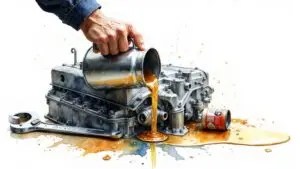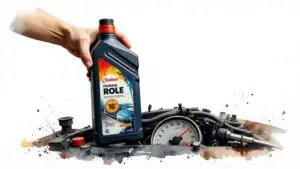Keeping Your Car in Tip-Top Shape
This car inspection checklist provides a quick, 7-point guide to keep your vehicle running smoothly and avoid costly repairs. From tires and brakes to fluids and lights, this list helps you identify potential problems before they become major headaches. Regularly using this car inspection checklist ensures your safety on the road, extends your vehicle's lifespan, and can even save you money in the long run. Whether you live in Haltom City, Keller, Watauga, or North Richland Hills, TX, this checklist will help you maintain your car's health.
1. Tire Condition & Pressure
Tire condition and pressure are paramount for safe and efficient driving. This crucial aspect of your car inspection checklist involves a comprehensive assessment of all tires, including the spare, covering inflation pressure, tread depth, wear patterns, damage, and age. As the only contact point between your vehicle and the road, tires directly impact handling, braking, and overall safety. Neglecting tire maintenance can lead to decreased fuel efficiency, premature wear, and potentially dangerous driving conditions. This is especially important for residents of Haltom City, Keller, Watauga, and North Richland Hills, TX, where varying road conditions and temperatures can impact tire performance.
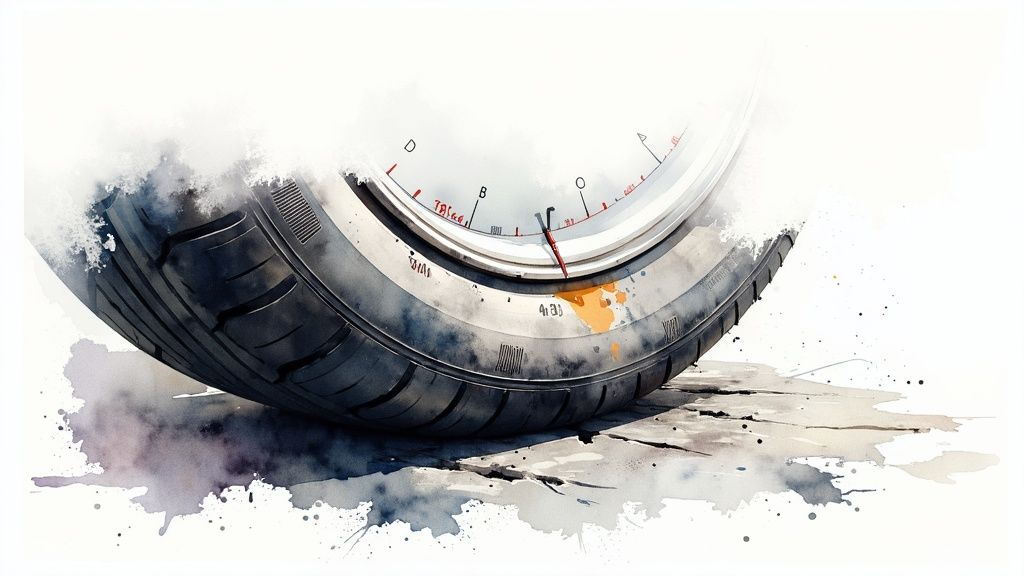
A thorough tire inspection involves several key features: measuring tread depth (the legal minimum is typically 2/32 of an inch), inspecting sidewalls for cracks, bulges, or cuts, verifying tire pressure against the manufacturer's specifications, checking the tire's age (most tires should be replaced after 6-10 years regardless of wear), and analyzing uneven wear patterns that may indicate alignment issues. These checks are vital for maintaining optimal tire performance and extending their lifespan.
Pros:
- Improved Safety: Proper tread depth and inflation ensure optimal road grip and handling, especially in adverse weather conditions.
- Increased Fuel Efficiency: Correctly inflated tires minimize rolling resistance, leading to better gas mileage.
- Extended Tire Life: Early identification of wear and tear allows for timely intervention, preventing premature tire failure and maximizing tire lifespan.
- Reveals Potential Problems: Uneven wear patterns can indicate alignment or suspension issues that, if left unaddressed, can compromise safety and lead to more costly repairs down the line.
Cons:
- Requires Specialized Tools: Accurate tread depth measurement necessitates a tread depth gauge. While pressure gauges are readily available, accurate readings require understanding temperature fluctuations.
- Tire Pressure Fluctuation: Temperature changes can affect tire pressure, making regular checks essential.
- Hidden Damage: Visual inspections may not reveal internal tire damage, requiring professional assessment in some cases.
Examples of Successful Implementation:
Many service centers offer free tire inspections, providing a convenient way to monitor tire health. Discount Tire is a notable example. Organizations like AAA offer mobile inspection services that include comprehensive tire checks, bringing the inspection directly to you. These services are particularly beneficial for busy professionals and fleet managers in the DFW area, including Haltom City, Keller, Watauga, and North Richland Hills.
Actionable Tips:
- Check Tire Pressure When Cold: Tire pressure should be checked when the tires are "cold" – meaning they haven't been driven for at least three hours – for the most accurate reading.
- The Penny Test: Insert a penny with Lincoln's head upside down into the tread. If you can see all of Lincoln's head, the tread is too worn, and the tire needs replacement.
- Check the Manufacturing Date: Look for the four-digit number on the tire sidewall indicating the week and year of manufacture. This helps determine tire age and replacement needs.
- Rotate Tires Regularly: Rotate tires every 5,000-8,000 miles to promote even wear and extend tire life.
Why This Item Deserves Its Place in the Car Inspection Checklist:
Tires are fundamental to vehicle safety and performance. Including tire condition and pressure in your car inspection checklist prioritizes safety, improves fuel efficiency, and can prevent costly repairs down the road. Regular checks and proactive maintenance ensure optimal tire performance and contribute to a safer, more efficient driving experience.
Popularized By: Tire manufacturers like Michelin and Goodyear actively promote tire safety through public awareness campaigns. The National Highway Traffic Safety Administration (NHTSA) also emphasizes the importance of tire maintenance through public safety initiatives.
2. Brake System Inspection
A critical part of any car inspection checklist is a thorough evaluation of the brake system. This comprehensive assessment examines all components responsible for slowing and stopping your vehicle, ensuring your safety on the road. A brake system inspection covers brake pads/shoes, rotors/drums, calipers, brake lines, fluid level, and the emergency brake. Neglecting this crucial system can lead to accidents and costly repairs down the line, making it a vital part of responsible vehicle ownership.
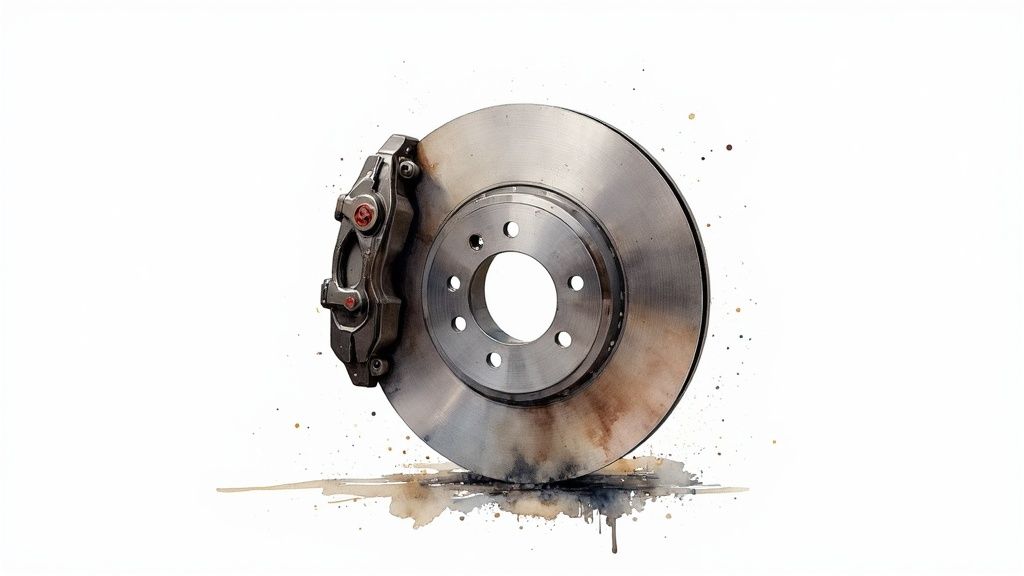
The inspection involves several key checks. Technicians will measure brake pad thickness, as pads thinner than 3-4mm typically require replacement. They also inspect rotors and drums for scoring, warping, or cracks, which can compromise braking performance. The inspection also includes checking brake fluid level and condition, as well as examining brake lines and hoses for leaks or damage. Finally, the functionality of the emergency brake is tested to ensure it engages properly.
This item deserves a place on the car inspection checklist because it directly impacts your vehicle's stopping ability and overall safety. Proactive brake system inspections prevent costly repairs by identifying issues early, address noises or vibrations related to braking, and can even pinpoint potential hydraulic system problems before complete failure. For residents of Haltom City, Keller, Watauga, and North Richland Hills, TX, regular brake inspections are especially important given the varied driving conditions and traffic patterns in these areas.
Features and Benefits:
- Brake pad thickness measurement: Ensures adequate friction material for safe stopping.
- Rotor/drum inspection: Identifies potential problems like warping or cracking that can reduce braking effectiveness.
- Brake fluid check: Determines fluid level and condition, vital for proper hydraulic function.
- Brake line inspection: Checks for leaks and damage that could lead to brake failure.
- Emergency brake test: Verifies the functionality of the parking brake system.
Pros:
- Directly impacts vehicle stopping ability and safety.
- Prevents costly repairs by catching issues early.
- Addresses issues that may cause noise or vibration.
- Can identify hydraulic system problems before failure.
Cons:
- A full inspection often requires wheel removal.
- Some components are difficult to visually inspect without disassembly.
- Brake feel is subjective and may require road testing.
Examples:
- Midas offers comprehensive brake inspections with detailed reports.
- Many dealership multi-point inspections emphasize brake system health.
Tips for Car Owners:
- Listen for grinding, squealing, or squeaking noises when braking.
- Check for pedal softness or excessive travel, which may indicate air in the brake lines.
- Note if the vehicle pulls to one side during braking, suggesting uneven brake function.
- Brake fluid should be clear to amber; dark fluid indicates contamination.
- Replace brake fluid every 2-3 years regardless of appearance.
Companies like Brembo and Akebono, manufacturers of brake components, and auto repair chains such as Jiffy Lube and Firestone, through their service packages, have popularized the importance of regular brake system inspections. By including this crucial check in your car inspection checklist, you are prioritizing your safety and the longevity of your vehicle. Whether you're a busy professional, a fleet manager, or simply a safety-conscious driver, a regular brake system inspection is a non-negotiable element of proper car maintenance.
3. Fluid Levels & Condition
A crucial part of any car inspection checklist involves checking your vehicle's fluid levels and their condition. This encompasses inspecting vital fluids such as engine oil, transmission fluid, coolant/antifreeze, brake fluid, power steering fluid, and windshield washer fluid. These fluids are the lifeblood of your vehicle, ensuring proper operation, lubrication, cooling, and the functionality of critical safety systems. Neglecting these fluids can lead to major mechanical failures, impacting performance, safety, and ultimately, your wallet.
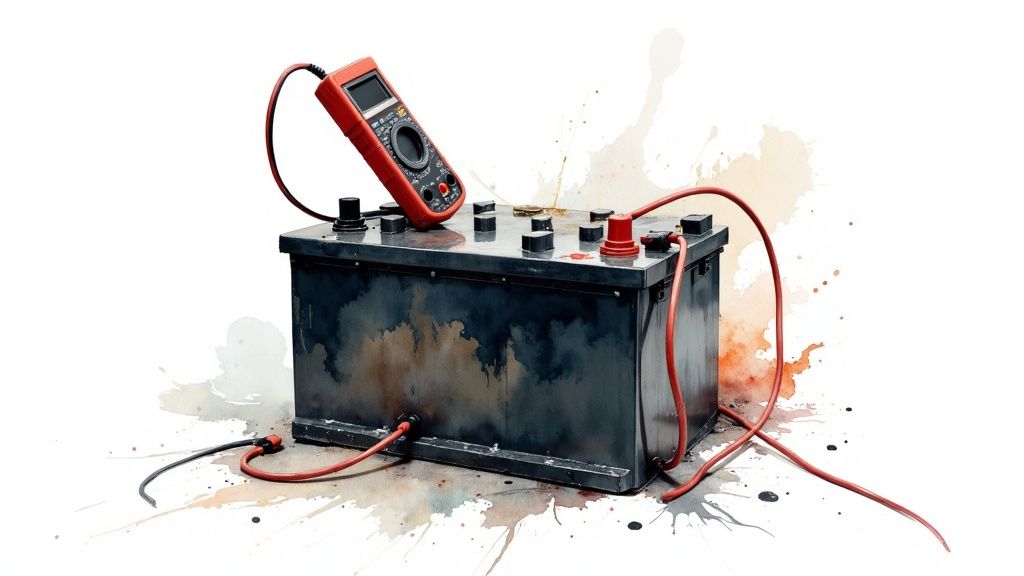
A thorough fluid level and condition check involves several key features: visually inspecting fluid levels against the minimum and maximum indicators on the reservoirs, assessing the color and condition of each fluid (looking for discoloration, cloudiness, or debris), checking for leaks around fluid reservoirs and under the vehicle, performing a specific gravity test for coolant to ensure proper freeze protection, and verifying fluid change intervals against the manufacturer's recommended maintenance schedule.
Why This Check Matters: This step in your car inspection checklist is vital for preventing costly repairs down the road. Maintaining proper fluid levels and quality optimizes vehicle performance, improves fuel efficiency, and extends the life of critical components like your engine and transmission. For residents of Haltom City, Keller, Watauga, and North Richland Hills, TX, regular fluid checks can be especially important given the varying weather conditions that can impact fluid performance.
Pros:
- Prevents major mechanical failures and expensive repairs.
- Optimizes vehicle performance and fuel efficiency.
- Extends engine and transmission life.
- Many fluids can be checked easily without specialized tools.
Cons:
- Some modern vehicles have sealed systems, making DIY checks difficult.
- Checking transmission fluid often requires the engine to be running at operating temperature.
- Assessing the actual quality of some fluids requires specialized testing equipment.
Examples:
- Quick lube centers like Valvoline Instant Oil Change perform these checks as part of their standard service.
- High-end vehicles like BMWs utilize Condition Based Servicing, which employs sensors to monitor fluid conditions and alert drivers when service is needed.
Actionable Tips:
- Check your oil level with the vehicle parked on level ground after the engine has been off for 5-10 minutes.
- Coolant should only be checked when the engine is cool to avoid burns.
- Transmission fluid is typically checked with the engine running and warm.
- Note any fluid with an unusual odor (burning smell) or appearance (milky, foamy).
- Maintain a logbook to track fluid changes and top-offs. This helps ensure you stay on top of your maintenance schedule.
When and Why to Use This Approach: This check should be part of your regular car maintenance routine. It's especially important before long trips, during seasonal changes (particularly before winter), and if you notice any unusual performance issues with your vehicle. For busy professionals in the DFW area, incorporating this into a routine service visit at a trusted mechanic can save time and provide peace of mind. Fleet managers in Haltom City, Keller, Watauga, and North Richland Hills can utilize this checklist item to ensure the longevity and performance of their company vehicles. This proactive approach, promoted by companies like Mobil, Castrol, AutoZone, and Advance Auto Parts (through educational materials and free fluid checks), and reinforced by vehicle manufacturers' maintenance schedules, is a cornerstone of preventative car care and helps ensure a safe and reliable driving experience.
4. Battery & Electrical System
A reliable battery and a fully functioning electrical system are absolutely essential for a safe and dependable vehicle. This part of your car inspection checklist focuses on evaluating the battery's health, the charging system's performance, and the overall condition of the electrical components, including lights, fuses, and connections. This system powers everything from starting the engine and illuminating the road to operating critical safety features like airbags and anti-lock brakes. A thorough inspection can prevent unexpected breakdowns and ensure your vehicle operates safely and efficiently.

The inspection process involves several key checks: a battery voltage test to measure its charge (a healthy battery reads 12.4-12.7V when off and 13.7-14.7V when running), a battery load test to assess performance under stress, and a terminal inspection to check for corrosion and secure connections. The charging system, primarily the alternator, is also evaluated by measuring its output. Finally, all lights, signals, and electronic accessories are checked for proper functionality.
Why this is crucial for your car inspection checklist: A failing battery or electrical system can lead to a range of problems, from a simple inconvenience like a dead battery to serious safety hazards like malfunctioning headlights or brake lights. Regular inspections can identify these issues early, preventing costly repairs and ensuring your safety on the road. This is especially important for residents of Haltom City, Keller, Watauga, and North Richland Hills, TX, where extreme temperatures can impact battery performance.
Features and Benefits:
- Prevents unexpected starting failures: Regular testing identifies weak batteries before they leave you stranded.
- Identifies charging system issues: Catching alternator problems early can prevent battery damage and costly replacements.
- Ensures critical safety features function correctly: A healthy electrical system powers essential safety components like lights, sensors, and electronic stability control.
- DIY-friendly tests: Many basic checks, like voltage testing, can be done with an affordable multimeter.
Pros:
- Increased vehicle reliability and safety.
- Early detection of potential problems saves money on repairs.
- Some tests are easy and inexpensive to perform.
Cons:
- Comprehensive testing requires specialized equipment.
- Modern vehicles with complex electronics may require dealer-level diagnostics.
- Battery testing is less accurate in extreme temperatures.
Examples:
- AutoZone and O'Reilly Auto Parts offer free battery testing services.
- AAA mobile service provides roadside battery testing and replacement.
Actionable Tips:
- Look for the battery manufacture date and consider replacement after 3-5 years, regardless of apparent performance.
- Clean corroded battery terminals with a wire brush and a baking soda and water solution.
- Check that headlights don't dim significantly when the engine is idling, which could indicate a charging system problem.
- Inspect the battery case for swelling or leakage, signs of a failing battery.
- Consider a trickle charger for vehicles used infrequently, especially during colder months.
Popularized By:
- Battery manufacturers like Interstate and Optima.
- Automotive electrical system suppliers like Bosch and Denso.
- Roadside assistance providers like AAA.
By including the battery and electrical system in your car inspection checklist, you are taking a proactive step towards ensuring the reliability, safety, and longevity of your vehicle.
5. Suspension & Steering Components
This crucial part of your car inspection checklist focuses on the intricate network of parts that dictate your vehicle's handling, stability, and ride comfort. A thorough inspection of your suspension and steering components is vital for maintaining control, especially during emergency maneuvers, and ensuring a safe and comfortable driving experience. This check covers shock absorbers/struts, ball joints, tie rods, control arms, bushings, and the power steering system. These components work together to keep your tires firmly planted on the road and allow you to steer effectively. Neglecting these systems can compromise your safety and lead to expensive repairs down the line. This is why a proper suspension and steering inspection deserves a prominent place on your car inspection checklist.
How it Works:
The suspension system absorbs impacts from the road, keeping the tires in contact with the surface. The steering system translates your input at the steering wheel into the movement of the front wheels. These two systems are closely intertwined, working together to maintain directional control and stability.
Features of a Thorough Inspection:
- Bounce Test: This simple test helps determine the effectiveness of your shock absorbers/struts by checking how quickly the vehicle returns to its normal position after being bounced.
- Steering Play and Responsiveness Assessment: Checking for excessive play or looseness in the steering wheel helps identify worn-out components like tie rod ends or steering rack issues. A responsive steering feel is crucial for safe maneuvering.
- Visual Inspection: A careful visual examination of rubber bushings and boots can reveal signs of deterioration, cracks, or dry rot, indicating potential problems.
- Ball Joint and Tie Rod End Play Check: Checking for play in these critical joints is essential for identifying wear that could lead to loss of control.
- Wheel Bearing Noise and Movement Evaluation: Unusual noises or excessive movement in the wheel bearings can signal impending failure and should be addressed promptly.
Pros:
- Directly Impacts Vehicle Handling and Safety: A well-maintained suspension and steering system ensures predictable and safe handling.
- Prevents Abnormal Tire Wear Patterns: Proper alignment and functioning suspension components contribute to even tire wear and longer tire life.
- Improves Ride Comfort and Stability: A healthy suspension absorbs bumps and vibrations, providing a smoother and more comfortable ride.
- Can Identify Dangerous Component Failures Before They Occur: Regular inspections can catch worn parts before they fail catastrophically, preventing accidents.
Cons:
- Many Components Difficult to Inspect without Lifting Vehicle: A thorough inspection often requires lifting the vehicle for proper access.
- Requires Experience to Distinguish Normal Wear from Critical Issues: A trained mechanic can best assess the severity of wear and tear.
- Some Tests Require Specific Loading Conditions or Specialized Tools: Advanced diagnostics may require specialized equipment.
Examples of Successful Implementation:
- Firestone Complete Auto Care (and similar service providers) offer specific suspension inspection packages.
- Car dealerships often include suspension checks in pre-purchase inspections.
Actionable Tips for Car Owners in Haltom City, Keller, Watauga, and North Richland Hills, TX:
- Listen for clunking or knocking noises when driving over bumps.
- Check for uneven tire wear, which can indicate suspension issues.
- Observe if the vehicle sags on one corner when parked.
- Test the steering for a responsive feel without excessive play.
- Inspect for fluid leaks around shock absorbers and power steering components.
Popularized By:
- Suspension component manufacturers like KYB and Monroe
- Performance suspension companies like Bilstein and Koni
- Vehicle safety organizations promoting handling stability
When and Why to Use This Approach:
Including a suspension and steering component check in your regular car inspection checklist is crucial for maintaining safety and preventing costly repairs. This is particularly important before long trips, after hitting a pothole or curb, or if you notice any changes in your vehicle's handling or ride quality. For residents of Haltom City, Keller, Watauga, and North Richland Hills, TX, ensuring your vehicle is ready for the varied road conditions is essential. Prioritizing this aspect of your car's maintenance will contribute to a safer and more enjoyable driving experience.
6. Engine Performance & Emissions
A crucial part of any thorough car inspection checklist is the assessment of engine performance and emissions. This inspection focuses on ensuring your engine runs efficiently, delivers the expected power, and meets emissions standards. It involves checking various components, including spark plugs, the air filter, the fuel system, the exhaust system, and the onboard diagnostic (OBD) system. This item deserves its place on the checklist because a healthy engine is fundamental to a well-functioning vehicle and ignoring potential problems can lead to costly repairs down the line. This is especially important for residents of areas like Haltom City, Keller, Watauga, and North Richland Hills, TX, where regular vehicle maintenance is essential for navigating the Texas terrain.
How it Works:
Engine performance and emissions inspections utilize a combination of visual inspections and advanced diagnostic tools. A visual check of belts and hoses for cracks or wear is often the first step. The air filter is examined for clogging and overall condition. The exhaust system is observed for leaks and unusual smoke colors (blue, black, or white), which can indicate underlying issues. For a deeper dive, technicians use OBD-II diagnostic tools to scan for engine fault codes. These codes pinpoint specific problems within the engine's electronic control systems. Further tests, like fuel system pressure testing and vacuum line integrity checks, may be conducted to isolate the root cause of any identified problems.
Features:
- Engine fault code scanning with OBD-II diagnostic tools
- Visual inspection of belts and hoses for cracks or wear
- Air filter condition check
- Exhaust smoke analysis
- Fuel system pressure testing
- Vacuum line integrity check
Pros:
- Identifies problems affecting fuel economy
- Ensures vehicle passes emissions testing, a requirement in many states like California.
- Can catch small issues before they cause major failures, saving you money in the long run.
- Many modern issues can be readily identified through computer diagnostics.
Cons:
- Complete diagnostics often require specialized equipment, typically found in professional auto repair shops.
- Some issues may be intermittent and difficult to diagnose, requiring more extensive testing.
- Modern engine components can be difficult to access, potentially increasing labor costs for repairs.
Examples:
- Emissions testing facilities in states with inspection requirements, like California, perform basic engine performance and emissions checks.
- ASE-certified master technicians perform complete engine diagnostics, including in-depth analysis and troubleshooting, offering a higher level of expertise for complex issues. This is especially beneficial for drivers in Haltom City, Keller, TX, Watauga, TX, and North Richland Hills, TX seeking expert care for their vehicles.
Tips for Car Owners:
- Note any check engine light illumination or flashing – these are important indicators of potential problems.
- Listen for unusual noises like knocking, ticking, or whistling emanating from the engine compartment.
- Monitor for unusual exhaust smoke colors (blue, black, or white) as these can signal issues with oil consumption, fuel mixture, or coolant leaks.
- Basic OBD-II scanners are affordable and readily available for DIY diagnostics, allowing you to check for simple codes yourself.
- Regular oil changes are crucial for engine longevity and performance. Don't neglect this essential maintenance task.
Why This Item is Important:
Engine performance and emissions inspections are vital for maintaining a healthy and efficient vehicle. They not only help ensure your car runs smoothly and reliably but also contribute to environmental protection by minimizing harmful emissions. Whether you're a local vehicle owner in Haltom City, a busy professional in Keller, or a fleet manager in North Richland Hills, TX, prioritizing engine performance and emissions checks is an investment in the longevity and value of your vehicle. For safety-conscious drivers and business owners in Watauga, TX and surrounding areas, this inspection offers peace of mind knowing your vehicles meet safety and environmental standards. Ignoring this critical aspect of car maintenance can lead to decreased fuel efficiency, costly repairs, and potential failures that leave you stranded.
7. Exterior & Safety Equipment
This crucial step in your car inspection checklist focuses on the exterior components and safety equipment that contribute significantly to your safety on the road and the overall structural integrity of your vehicle. A thorough inspection of these elements ensures optimal visibility, protects you and your passengers in the event of an accident, and can even prevent costly repairs down the line. This is why a careful exterior and safety equipment check deserves a prominent place on any car inspection checklist.
What it Involves:
The exterior and safety equipment inspection encompasses a range of checks, including:
- Functionality Check of All Exterior Lights: This includes headlights (high and low beams), taillights, brake lights, turn signals, hazard lights, and parking lights.
- Windshield Condition Assessment: Look for cracks, chips, or any damage that could obstruct your view.
- Wiper Blade Condition and Performance: Check for wear and tear, cracking, and ensure they effectively clear the windshield without streaking or chattering.
- Mirror Adjustment and Condition: Verify that all mirrors (side and rearview) are properly adjusted and free from damage.
- Body and Undercarriage Inspection: Examine the body panels for dents, rust, and any signs of previous repairs. Inspect the undercarriage for rust, damage to the exhaust system, and leaks.
- Safety Restraint System Check: Ensure seat belts buckle and unbuckle smoothly, and check the airbag indicator light to confirm the system is functioning correctly.
Benefits of a Thorough Inspection:
- Enhanced Safety: Properly functioning lights and wipers are essential for safe driving, particularly in adverse weather conditions. Intact safety restraints are your first line of defense in an accident.
- Preventive Maintenance: Identifying rust or damage early can prevent more extensive and costly repairs later. Regular checks can also reveal minor issues with lights and wipers before they become safety hazards.
- Peace of Mind: Knowing that your vehicle's exterior and safety systems are in good working order provides valuable peace of mind.
Pros:
- Many issues, like burnt-out bulbs or damaged wipers, are easily identifiable visually without tools.
- Directly impacts visibility and safety, especially during nighttime driving or inclement weather.
- Early detection of rust can prevent significant structural damage.
- Light and wiper issues are typically inexpensive to correct.
Cons:
- Some modern lighting systems, such as adaptive headlights or LED assemblies, can be complex and expensive to repair.
- Advanced driver-assistance systems (ADAS), which often utilize exterior sensors and cameras, may require specialized dealer equipment for proper testing.
- Assessing the extent of rust damage can be subjective without professional tools and expertise.
Examples of Implementation:
State vehicle inspection programs almost universally include checks of exterior lighting and safety equipment. Pre-purchase inspections, such as those offered by CARFAX, also incorporate detailed exterior assessments. These examples highlight the importance of these checks for both legal compliance and ensuring vehicle safety.
Actionable Tips for Your Car Inspection Checklist:
- Test all lights with a helper or by observing their reflection on a garage door or wall.
- Check headlight aim against a wall or garage door at night to ensure proper alignment.
- Replace wiper blades that streak, chatter, or leave portions of the windshield uncleared.
- Small windshield chips should be repaired promptly to prevent them from spreading.
- Regularly inspect under the vehicle and in the wheel wells for signs of developing rust, particularly if you live in an area with harsh winters or coastal environments.
Why this is Important for Drivers in Haltom City, Keller, Watauga, and North Richland Hills, TX:
The weather conditions in North Texas, including heavy rain and occasional hail, make a thorough exterior and safety equipment inspection especially important for drivers in our area. Ensuring your lights, wipers, and other safety systems are in top condition is crucial for navigating these conditions safely. Regular inspections can also help protect your vehicle from the damaging effects of our hot summers and potential for rust.
7-Point Car Inspection Checklist Comparison
| Checklist Item | Implementation Complexity 🔄 | Resource Requirements ⚡ | Expected Outcomes 📊 | Ideal Use Cases 💡 | Key Advantages ⭐ |
|---|---|---|---|---|---|
| Tire Condition & Pressure | Moderate; requires tires tools & visual checks | Tread depth gauge, pressure gauge | Improved safety, fuel efficiency, extended tire life | Regular safety checks, pre-trip inspections | Early detection of wear and alignment issues |
| Brake System Inspection | High; often requires wheel removal and some disassembly | Brake measuring tools, fluid testers | Reliable stopping, prevention of costly repairs | Annual maintenance, safety inspections | Prevents brake failures, detects hydraulic issues |
| Fluid Levels & Condition | Low to Moderate; mostly visual and simple tests | Dipsticks, color observation, leak checks | Prevents mechanical failures, maintains performance | Monthly checks, pre-trip inspections | Many checks possible without specialized tools |
| Battery & Electrical System | Moderate; voltage/load tests with some equipment | Multimeter, load tester | Prevents start failures, electrical system reliability | Seasonal checks, battery health monitoring | Early identification of charging/battery issues |
| Suspension & Steering Components | High; requires lifting vehicle and experience | Specialized inspection tools, vehicle lift | Improved handling, safety, ride comfort | Pre-purchase inspections, handling performance checks | Identifies critical component wear/failures |
| Engine Performance & Emissions | High; needs diagnostic tools & possible disassembly | OBD-II scanner, pressure gauges | Optimized fuel economy, emissions compliance | Emission testing, troubleshooting engine issues | Catches issues early via advanced diagnostics |
| Exterior & Safety Equipment | Low; mostly visual and functional tests | Basic tools, helpers for light checks | Ensures visibility, occupant safety, structural integrity | Routine inspections, pre-sale or seasonal checks | Easy identification of common wear & damage |
Hit the Road with Confidence
Regularly reviewing your vehicle with a comprehensive car inspection checklist is paramount for safe and reliable driving. From checking tire condition and pressure to ensuring your brake system and fluids are in top shape, each item on this list plays a crucial role. Don't forget the importance of a healthy battery and electrical system, along with sound suspension, steering, and a well-performing engine. Finally, confirming your exterior and safety equipment are functioning correctly provides an extra layer of security on the road. Mastering these checks allows you to identify potential problems early, saving you time, money, and potential headaches down the line. This proactive approach not only maintains optimal vehicle performance but also prioritizes the safety of you, your passengers, and other drivers on the road, especially in busy areas like Haltom City, Keller, Watauga, and North Richland Hills, TX.
For a more comprehensive guide to car maintenance, check out this helpful resource: car maintenance checklist. This ultimate car maintenance checklist from Kwik Kar Oil Change and Auto Care provides valuable insights into extending the life and performance of your vehicle.
Remember, a well-maintained car contributes to peace of mind and a smoother driving experience. Ready to entrust your vehicle to the experts? Express Lube and Car Care in Haltom City specializes in providing top-notch inspections and maintenance based on a detailed car inspection checklist, keeping your vehicle running smoothly. Visit Express Lube and Car Care today for all your automotive needs.



